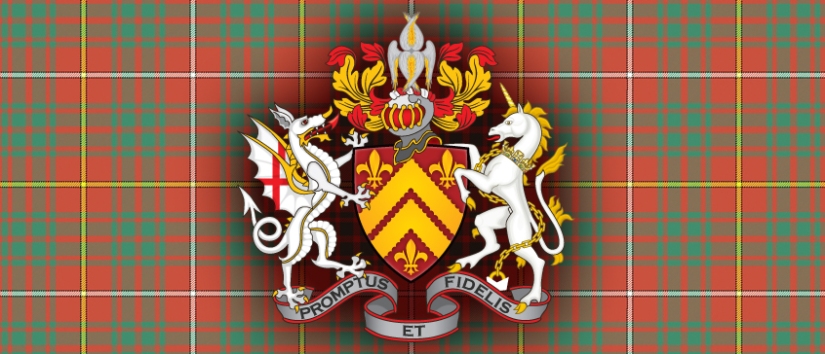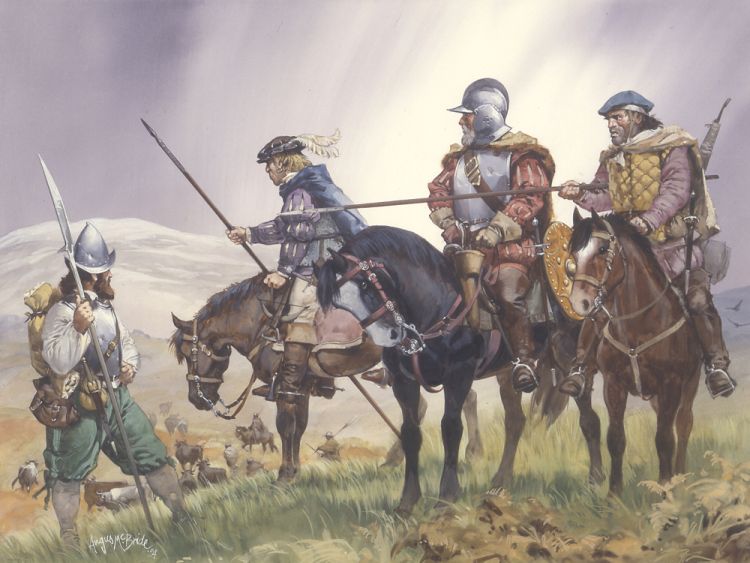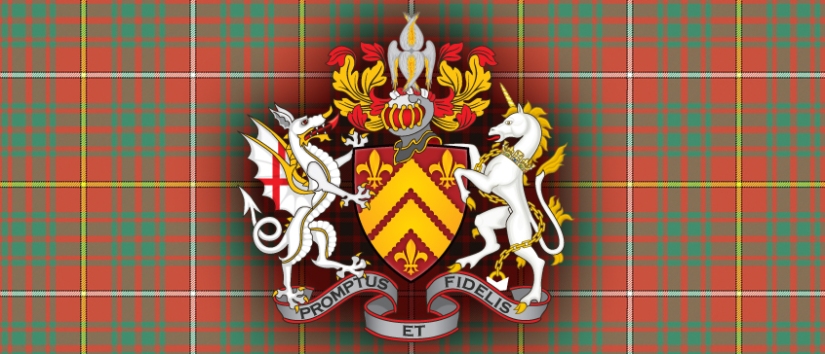CLAN CARRUTHERS INT SOCIETY CCIS PROMPTUS ET FIDELIS

STEEL BONNET AND LANCE
The Border Reiver was a specialist, and needed special equipment, the most important part of which was his horse. “They reckon it a great disgrace for anyone to make a journey on foot,” wrote Leslie, and Froissart had noted two centuries earlier how the Scots at war “are all a-horseback . . . the common people on little hackneys and geldings.” The Border horses, called hobblers or hobbys, were small and active, and trained to cross the most difficult and boggy country, “and to get over where our footmen could scarce dare to follow.”
Such precious animals naturally attracted legislation, particularly in England, where horses were in short supply. In the late 1500s their export to Scotland was strictly banned; Hunsdon “condemde sundry” for this treason in 1587, and complained that English gentlemen were involved in the illicit trade. It was a well-broken law in both directions, for Scotland had banned horse export twenty years earlier, with no great success.

The Scots had long been noted horse-breeders, so much so that legislation was occasionally passed to restrain production. By statute of 1214 every Scot of property must own at least one horse, and in 1327 the country could put 20,000 cavalry into the field. Export to England at that time was highly profitable, and was carried on even by men of rank. The Stuart kings imported from Hungary, Poland, and Spain to improve the breed, and there emerged the small, swift unusually hardy mounts which in James IV’s time were reputed to be able to cover as much as 150 miles in a day. They must have been short miles.
However, even allowing for exaggeration, such horses were ideal all-purpose mounts both for peace-time raiders and war-time light cavalry. They enabled the Border riders to muster and move men at high speed over remarkable distances. A leader like young Buccleuch could raise 2000 horse at short notice, able to strike faster and at far greater range than would have seemed credible to an ordinary cavalry commander; between sixty and eighty miles a day seems to have been within their capability. In addition, the horses were cheap to buy and easy to maintain: there is evidence that they did not even need shoeing.
The Border rider, as he sat his hobbler, was a most workmanlike figure, far more streamlined than the ordinary cavalryman of his time. His appearance was “base and beggarly” by military standards, and this applied to the lords as well as to the lowly. “All clad a lyke in jackes cooverd with whyte leather, dooblettes of the same or of fustian, and most commonly all white hosen,” Patten noted after Pinkie (1547). “Not one with either cheine, brooch, ryng or garment of silke that I coold see. . . . This vilnes of port was the caus that so many of their great men and gentlemen wear kyld and so fewe saved. The outwarde sheaw . . . whearby a stranger might discern a villain from a gentleman, was not amoong them to be seen.”
On his head the rider wore the steel bonnet, which in the early part of the century was usually the salade hat, basically a metal bowl with or without a peak, or the burgonet, a rather more stylish helmet which, in its lightest form, was open and peaked. These head-pieces, many of which would be home-made by local smiths, were gradually replaced in Elizabethan times by the morion, with its curved brim, comb, and occasional ear pieces.
Over his shirt the rider might wear a mail coat, but the more normal garment was the jack, a quilted coat of stout leather sewn with plates of metal or horn for added protection. It was far lighter than armour, and almost as effective against cuts and thrusts; backs and breasts of steel might be worn by the wealthier Borderers, but for horsemen whose chief aim was to travel light they were a mixed blessing. The Scots Borderers were officially recognised by the Privy Council as “licht horsemen” who were not obliged to serve in heavy armour during war; the English Borderers, when employed on campaigns, were similarly used as scouts and “prickers”.
Leather boots and breeches completed the clothing, which was without badges except in war-time, when the riders wore kerchiefs tied round their arms as signs of recognition, as well as the crosses of St George or St Andrew, according to their nationality—or their allegiance. Embroidered letters attached to their caps were also used for war-time identification. (There was a suspicion in the English Army in the 1540s that the English March riders used these identifying signs not only to be known to each other, but “that thei used them for collusion, and rather bycaus thei might be knowen to th’enemie, as the enemies are knowen to them, for thei have their markes too, and so in conflict either each to spare other, or gently each to take other. Indede men have becen mooved the rather to thinke so, bycaus sum of their crosses—the English red cross—were so narrow, and so singly set on, that a puff of wynde might blowed them from their breasts.”)
This light and serviceable costume, so suitable for the cut-and-run activities of its wearer, reflected also the changing military patterns of the day. The sixteenth century saw a revolution in warfare; it was the bridge between the medieval knights and men-at-arms, with their heavy armour and weapons, and the age of firepower.
Gunpowder had come into its own, and when it was discovered that mail did not stop a bullet, the whole concept of protective equipment changed. Long leather boots took the place of greaves, plate gave way to the reinforced coat, and the knight’s casque to the open helmet.
The great change, of course, was in missile weapons. For two centuries England’s military thinking had been dominated by one of the most lethal hand weapons in the history of warfare: the six-foot long bow with which the English peasant had mastered the powers of chivalry. Naturally, England was reluctant to change from this proven battle-winner, and in this as in most other military developments she lagged behind the Continent, even under such a war-conscious monarch as Henry VIII.
The hand-gun v. long bow controversy, which reached a climax in Elizabeth’s reign, was a bitter one. The bow school, apart from their sentimental reasons, urged the efficiency of the archer who could despatch twelve shots a minute into a man-sized target at 200 paces (practice at shorter ranges was actually forbidden in Henry’s time); against this the new arquebus could fire only ten to twelve shots an hour when Elizabeth came to the throne, although the rate had risen to thirty-five to forty by 1600. An arquebus was unsuitable in wet weather, it was cumbersome, and it cost 30s. (A bow cost about 6s 8d, with arrows). The Earl of Sussex, on the Border in 1569, demanded archers, not “ill-furnished harquebusiers”, and local opinion seems to have supported him; the tenants of Home Cultram, as late as 1596, rejected calivers as too expensive.
But the fire-arms lobby, which included such influential figures as the veteran Sir Roger Williams, eventually got their way; in the 1560s the majority of English infantry carried the long bow, but by 1600 it was virtually obsolete in the country as a whole. On the Border, however, where a light, rapid-fire weapon was needed, the bow lived longer; in Leith Ward, Cumberland, in 1580, the muster roll showed over 800 bowmen to nine arquebusiers, and in the 1583 muster the English West March counted 2500 archers, with no mention of fire-arms. Hundreds of hand-guns with ammunition were sent to Berwick in 1592, but the powder was unreliable, and as for the guns, “when they were shot in, some of them brake, and hurte divers mennes hands.” In the same year Richard Lowther asked only for bows for the defence of Carlisle.

Like the local peasant infantry, the Border riders also used the bow, but there is increasing mention as the century progresses of their carrying arquebuses, the light pieces called calivers, and the dag, the heavy hand-gun which was the rough equivalent of the modern large-calibre pistol.
The principal close-quarter weapons of the Border foot soldier were the bill, the long cleaver-cum-pike which had lasted through the Middle Ages, the spear, and a local arm called the Jedburgh axe, with a distinctive round cutting edge. Swords are seldom mentioned in the English muster rolls, but the March riders of both sides certainly carried them, occasionally with small shields.
However, in peace or war, the rider’s favourite weapon was the lance. These were sometimes over thirteen feet long, but usually must have been shorter. They were used couched, for thrusting, and also for throwing. Camden describes the Borderers on horseback spearing salmon in the Solway; anyone who has tried to spear fish on foot will appreciate the expertise required to do it from the saddle.
Eure pronounced on this Border skill without qualification: he found the March riders better at handling lances on horseback than Yorkshiremen, and “better prickers in a chase as knowing the mosses, more nimble on foot.”
This then was the Borderer’s armoury, for war-time campaign or peace-time raid. So if one mounts the reiver on his hobbler, with steel cap, jack, lance, cutting-sword, dagger, and hand-gun, he is fully equipped and ready to be pointed at the target—farm, village or grazing herd, peel tower or sheiling. This, quite literally, was his day’s work.
Preserving Our Past, Recording Our Present, Informing Our Future
Ancient and Honorable Carruthers Clan Int Society LLC
carrothersclan@gmail.com CARRUTHERSCLAN1@GMAIL.COM

You can find us on facebook at :
https://www.facebook.com/carrutherscarrothers.pat.9
https://www.facebook.com/CarruthersClan/
https://www.facebook.com/CarruthersClanLLC
Disclaimer Ancient and Honorable Carruthers Clan International Society CCIS LLC

















